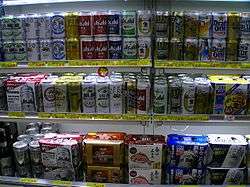発泡酒
Japanese

発泡酒: cans of beer, mostly happōshu, for sale in a discount store.
| Kanji in this term | ||
|---|---|---|
| 発 | 泡 | 酒 |
| はつ > はっ Grade: 3 |
ほう > ぽう Grade: S |
しゅ Grade: 3 |
| on’yomi | ||
Noun
発泡酒 (hiragana はっぽうしゅ, rōmaji happōshu)
- a beer made with less malt by weight than the percentage required to be officially labelled as “beer”, as defined by the Japanese tax code (and thus avoiding the higher taxes on official “beer”)
- 2016 December 13, “Bīru, happōshu, daisan no bīru tte, somo-somo nani ga chigau? [What's the actual difference between beer, happōshu, and third-category beer?]”, in Liquor Page:
- ビール、発泡酒と第3のビールの違いで、まず第一に挙げられるのが、使用が認められる原料の違いです。
- Bīru, happōshu to daisan no bīru no chigai de, mazu daīchi ni agerareru no ga, shiyō ga mitomerareru genryō no chigai desu.
- The first difference to be noted between beer, happōshu and third-category beer is the difference in the raw materials used.
- ビール、発泡酒と第3のビールの違いで、まず第一に挙げられるのが、使用が認められる原料の違いです。
-
Usage notes
Happōshu can be made with malt levels of 0% to 24% of the total fermentable ingredients by weight. Although it is sometimes equated with alcopop, happōshu is generally intended to at least resemble beer. The term became more widely used following changes in the Japanese tax code in the 1990s that levied higher taxes on beer made with higher percentages of malt. See the Wikipedia article for more details.
References
- 1988, 国語大辞典(新装版) (Kokugo Dai Jiten, Revised Edition) (in Japanese), Tōkyō: Shogakukan
- 2006, 大辞林 (Daijirin), Third Edition (in Japanese), Tōkyō: Sanseidō, →ISBN
This article is issued from
Wiktionary.
The text is licensed under Creative
Commons - Attribution - Sharealike.
Additional terms may apply for the media files.